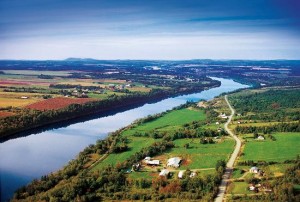
I have always dreamed of taking one more trip back to Caribou Maine where my maternal family hails from.
Caribou is the most northeastern city in the United States and a mere 10-12 miles from the province of New Brunswick in Canada. The estimated population in 2010 was 8,189.
The summers in Caribou are spectacular but the winters are frigid. The cold comes from Quebec into the valley along the Aroostook River and doesn’t move out for at least four months, giving Caribou a winter climate on a par with North Dakota and Minnesota.
The average seasonal snowfall for Caribou is approximately 109 inches. The first freeze of the season usually occurs sometime in mid-September, and the last freeze around mid-May. So Caribou has about 130 days of freeze-free weather. In January, the average low is only 1 degree.
I have always fondly recalled the long driving trips I took to Caribou with my mother and grandmother both in summer and winter. My memories of those trips have faded over the years, but I can still vividly recall picking wild blueberries, raspberries, and strawberries by the bushel-full right off the side of the roads flanked on both sides by a tapestry of majestic emerald green potato fields in the summer.
And in the winter, I will never forget how we would make fresh maple syrup from a spigot stuck in a tree, or ice skating, sledding, fretful drives on snow-covered roads, moose sightings, and snowmobiling. Caribou maintains over 170 miles of Aroostook County’s 1,600-mile groomed snowmobile trail systems—which have been rated the third-best in the nation.
But what will remain forever etched in my mind was that, winter or summer, Caribou had some of the most beautiful landscape I had ever seen, and a far cry from my poverty-stricken home base in Connecticut. I recall on so many lonely nights in our railroad apartment on Huron Street in Bridgeport, dreaming that Caribou was my home.
My grandmother was French-speaking and bilingual even though she hailed from the U.S. It didn’t matter whether you were on the American or Canadian side of the border at the time she grew up in Caribou, both French and English were spoken in the home. Her English was sometimes indecipherable, mainly because her enunciation of words as well as her accent were extremely thick. She called it the “Valley accent.” Anyone from the St. John Valley, whether it was the Maine or Canadian side, had a similar Franco-American accent.
For example, she would pronounce: the as “dah,” or three as “tree,” potato as “budayda,” mother as “mudder,” father as “fadder,” or the number 233 as “thoo turty tree.” To be honest, as a child who grew up hearing her speak both English and French, it was often easier for me to understand her French than her English.
I recall her telling me compelling stories about the Acadians’ arrival in the St. John River Valley, after being exiled from Canada, where many of the refugees had settled around 1755 to escape the British roundup, as well as her heartfelt memories of her life in and around Caribou. But I never wrote anything down nor did I pay much attention to the tales. How I wish I would have.
And my grandmother would sprinkle all of our conversations with sayings like, “The one you have, is worth more than the two you think you might get,” or “If the young knew and the old could,” or “After the storm comes good weather.” But her favorite saying was “plus ça change, plus c’est la même chose,” which means, “the more that changes, the more it’s the same thing.”
My grandmother also had several endearing pet names she would call me in French. Her favorite pet name for me was “Mon petit chou,” which means, “My little cabbage.” Now I really didn’t like being referred to as a gassy vegetable, but she said it with such fondness that I grew to love her quirky nickname for me. But my favorite pet name she called me was “Mon couer” which means, “My heart.” I was her heart, and she was mine.
It was my grandmother’s long life dream to someday move back to Maine, buy a small house and live out the rest of her life there. Unfortunately, the last time she was in Maine was with me—when I was about 7 or 8 years old.
It probably seems strange that someone who loved and dreamed of her home as much as she did, never returned for a visit. But it was a costly and time-consuming trip to make, and she never had the time off or the money to get back home. I often ask myself why I didn’t give her the money to go. I certainly could have. That question haunts me all the time.
In 1977, my grandmother sat me down to break the devastating news that she had been diagnosed with lung cancer. She was 58, and I was 24.
I was beyond words—dumbfounded, and afraid. But she wasn’t afraid of “the cancer” as she called it. She was afraid she wouldn’t make it back to her beloved Caribou. She asked me what I thought about her finally making the move back to her roots. She laid out a whole plan. She would drive over the steel bridge across the Aroostook River to Fort Fairfield Road in Caribou and take in the beauty of the rolling hills and fields where she grew up. She would go back to Eagle Lake, where she was born and then take the magnificent drive along the St. John River Valley to Van Buren. She’d buy a small house somewhere, and plant vegetables and fruit. She’d get back into canning and gardening, and maybe add a few chickens for fresh eggs.
I was agitated, but she was calm and rationalized that based on her diagnosis, she knew it was terminal and so it was finally time for her to make her move.
I was adamant that she stay in Connecticut. I convinced her not to go. I begged her not to leave me. And I pushed her to go through chemotherapy and radiation. And then I pushed her some more to have surgery to remove one of her lungs. I pushed and I pushed and I pushed.
I look back on all that now, and I realize how selfish I was. I should have encouraged her to live out her dream—the only dream she really ever had. She had such a difficult life, full of so many disappointments, with no possibility of a dream come true.
But I was in desperate need of her unconditional love, and her continuing presence. It was all about me.
What I should have done was to drive to Caribou with her, and help her find a place to live. I should have supported and assisted her in achieving the one and only dream she ever had.
Woulda, coulda, shoulda.
Needless to say, she never made it back to Caribou, or anywhere else. In 1983, six years after her cancer diagnosis, she lay dying in a hospital bed. She was distraught over her failing health, but she was more distressed about her decision not to move back to her cherished Caribou. “It’s not too late,” I reassured her, although we both knew it was a lie. She died that night.
Thirty-two years after her death, I decided to finally make the trip back to Caribou—for her. I did some research ahead of time, to make sure I visited and photographed all of the places she spoke so highly of, and that meant everything to her. Places like Grand Falls in New Brunswick, Eagle Lake, Presque Isle, Van Buren, and of course over the steel bridge and across the Aroostook River to Fort Fairfield Road in Caribou.
My first stop was in front of the Welcome to Caribou sign, where my husband took my photo. Unfortunately, the weather was rainy, cold, and disappointingly miserable.
My second stop was to Van Buren, along the St. John River Valley, where Maine is on one side of the narrow St. John River, and Canada on the other.
The Acadian culture still remains a significant part of everyday life in Van Buren, which is part of Aroostook County. At the Acadian Village there, I admired the ethereal 1,700-pound Italian marble statue of Evangeline, the lovesick Acadian refugee of Henry Wadsworth Longfellow’s poem about a couple parted by the British expulsion. His epic poem was published in 1847 and titled Evangeline: A Tale of Acadie. It was a work of fiction but based on historical fact. It was a story of a couple’s devotion, love, and ultimate separation on their wedding day, due to the deportation by the British, of the French Acadian people from Nova Scotia in 1755. Evangeline, the bride-to-be, wandered unsuccessfully for years in search of her one true love. As a result of his poem about Evangeline, Longfellow, who was born in Portland Maine, went on to become one of the most famous poets in America.
My third stop was to drive over the steel bridge to Fort Fairfield Road to see if it would spark a memory of where my great grandmother Julia Nadeau once lived. It was stormy and rainy, and there was a foggy mist obscuring the landscape. I wasn’t getting the money shot I had hoped for, that was for sure.
What struck me the most about its bewitchery was that fifty-plus years after the first time I laid eyes on it, the landscape had barely changed. It was still the same lush, endless fields and farms of emerald green I remembered as a child.
I had waited decades to stand at this very spot, drove over 600 miles, and wouldn’t be able to photograph it.
And then I realized that even if the day had been a spectacularly perfect one, no photo could have ever captured the panoramic, pristine beauty and serenity of the landscape before me. The one and only searing image of the money shot, would best and forever remain in the caverns of my mind. I had little regret because I knew that the beauteous view at the top of Fort Fairfield Road would stay with me for the rest of my life.
As I stood at the upper part of Fort Fairfield Road taking in the breathtaking spectacle of farm after farm, for as far as my eyes could see, I was overcome with an aura of peace and tranquility that I hadn’t felt in years.
When I got back to the car to drive away, the skies opened up and the sun peeked out just slightly. I could swear it was my grandmother looking down at me and saying, “After the storm comes good weather.”
As my husband drove away, I took a picture of the sky with my cell phone, and then softly replied to my grandmother that we were home.




